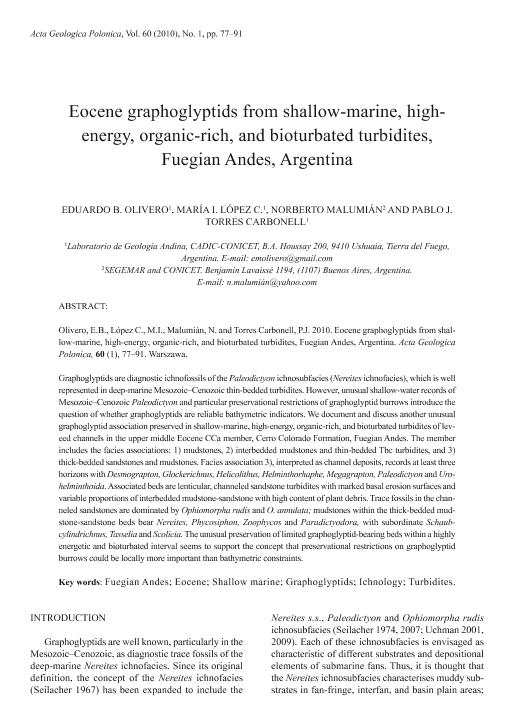Artículo
Eocene graphoglyptids from shallow-marine, high-energy, organic-rich, and bioturbated turbidites, Fuegian Andes, Argentina
Olivero, Eduardo Bernardo ; Lopez Cabrera O., Maria Isabel
; Lopez Cabrera O., Maria Isabel ; Malumian, Norberto
; Malumian, Norberto ; Torres Carbonell, Pablo Juan
; Torres Carbonell, Pablo Juan
 ; Lopez Cabrera O., Maria Isabel
; Lopez Cabrera O., Maria Isabel ; Malumian, Norberto
; Malumian, Norberto ; Torres Carbonell, Pablo Juan
; Torres Carbonell, Pablo Juan
Fecha de publicación:
02/2010
Editorial:
Wydawnictwo Naukowe Invit
Revista:
Acta Geologica Polonica
ISSN:
0001-5709
Idioma:
Inglés
Tipo de recurso:
Artículo publicado
Clasificación temática:
Resumen
Graphoglyptids are diagnostic ichnofossils of the Paleodictyon ichnosubfacies (Nereitesichnofacies), which is well represented in deep-marine Mesozoic–Cenozoic thin-bedded turbidites. However, unusual shallow-water records of Mesozoic–Cenozoic Paleodictyon and particular preservational restrictions of graphoglyptid burrows introduce the question of whether graphoglyptids are reliable bathymetric indicators. We document and discuss another unusual graphoglyptid association preserved in shallow-marine, high-energy, organic-rich, and bioturbated turbidites of leveed channels in the upper middle Eocene CCa member, Cerro Colorado Formation, Fuegian Andes. The member includes the facies associations: 1) mudstones, 2) interbedded mudstones and thin-bedded Tbc turbidites, and 3) thick-bedded sandstones and mudstones. Facies association 3), interpreted as channel deposits, records at least three horizons with Desmograpton, Glockerichnus, Helicolithus, Helminthorhaphe, Megagrapton, Paleodictyon and Urohelminthoida. Associated beds are lenticular, channeled sandstone turbidites with marked basal erosion surfaces and variable proportions of interbedded mudstone-sandstone with high content of plant debris. Trace fossils in the channeled sandstones are dominated by Ophiomorpha rudis and O. annulata; mudstones within the thick-bedded mudstone-sandstone beds bear Nereites, Phycosiphon, Zoophycos and Paradictyodora, with subordinate Schaubcylindrichnus, Tasselia and Scolicia. The unusual preservation of limited graphoglyptid-bearing beds within a highly energetic and bioturbated interval seems to support the concept that preservational restrictions on graphoglyptid burrows could be locally more important than bathymetric constraints.
Palabras clave:
FUEGIAN ANDES
,
EOCENE
,
SHALLOW MARINE
,
GRAPHOGLYPTIDS
,
ICNOLOGY
,
TURBIDITES
Archivos asociados
Licencia
Identificadores
Colecciones
Articulos(CADIC)
Articulos de CENTRO AUSTRAL DE INVESTIGACIONES CIENTIFICAS
Articulos de CENTRO AUSTRAL DE INVESTIGACIONES CIENTIFICAS
Articulos(SEDE CENTRAL)
Articulos de SEDE CENTRAL
Articulos de SEDE CENTRAL
Citación
Olivero, Eduardo Bernardo; Lopez Cabrera O., Maria Isabel; Malumian, Norberto; Torres Carbonell, Pablo Juan; Eocene graphoglyptids from shallow-marine, high-energy, organic-rich, and bioturbated turbidites, Fuegian Andes, Argentina; Wydawnictwo Naukowe Invit; Acta Geologica Polonica; 60; 1; 2-2010; 77-91
Compartir



